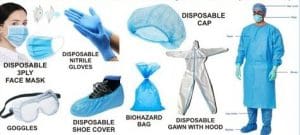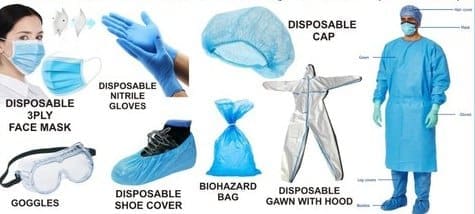INTRODUCTION
Coronaviruses are a large family of viruses, some causing illness in people and others that circulate among animals, including camels, cats and bats. Rarely, animal coronaviruses can evolve and infect people and then spread between people such as has been seen with MERS and SARS.The outbreak of Novel coronavirus disease (now named COVID-19) was initially noticed in mid-December, 2019, has spread to more than 185 countries/territories worldwide. The causative agent for COVID-19 earlier termed provisionally as novel Coronavirus has been officially named as SARS-CoV-2. WHO is providing technical information on appropriate available essential medical devices which are indispensable for treatment centres, community-based units and other preventive activities, in affected and neighbouring countries.There is clear evidence of human-to-human transmission mainly through respiratory droplets that get generated when people cough, sneeze, or exhale. It is also transmitted by touching, by direct touch and through contaminated surfaces or objects and then touching their own mouth, nose, or possibly their eyes. The people most at risk of COVID-19 infection are those who are in close contact with a suspect/confirmed COVID-19 patient or who care for such patients. This article discuss about the rational usage of personal protective equipments (PPE).
PERSONAL PROTECTIVE EQUIPMENT (PPE)
Personal Protective Equipment (PPE) is most important in preventing transmission of the Ebola virus not only in treatment centres but also various activities, e.g. cleaning, waste management and safe burials, and community care related to the outbreak. Personal Protective Equipments (PPEs) are protective gears designed to safeguard the health of workers by minimizing the exposure to a biological agent.Personal protective equipment, commonly referred to as “PPE”, is equipment worn to minimize exposure to hazards that cause serious workplace injuries and illnesses. These injuries and illnesses may result from contact with chemical, radiological, physical, electrical, mechanical, or other workplace hazards. Personal protective equipment may include items such as gloves, safety glasses and shoes, earplugs or muffs, hard hats, respirators, or coveralls, vests and full body suits.
TYPES OF PPE
- Gloves:Protects your hands from microbes and minimizes the possible spreading of microbes.
- Masks:Cover your mouth and nasal area. Some masks have a see-through plastic piece, which also covers your eyes (shield). A special respiratory mask (respirator) forms a tight seal around your nose and mouth. It can be useful to minimize the inhalation of smaller microbes, such as tuberculosis bacteria.
- Eye protection: This includes face shields as well as goggles. They can protect the mucous membranes of your eyes from bodily fluids. If the fluids make contact with the eyes, microbes within the fluid can enter the body through the mucous membranes.
- Clothing:Includes gowns, aprons, head covering, and shoe covers.
SELECTION OF APPROPRIATE PPE
It is important to consider the following factors which are influencing the selection of PPE:
- Type of anticipated exposure:Such as from touch or surfaces, splashes or sprays, or large volumes of bodily fluids, which may seep through the clothing. PPE selection (and combinations of PPE), is determined by the category of isolation of the patient being treated.
- Durability and appropriateness of the PPE for the task. This will affect, for example, whether a gown or apron is selected. If a gown is required, the type of gown is also important. Does it need to be fluid resistant, fluid proof, both or neither.
- Fitting.PPE must fit the individual user (form a proper seal). For example; if a glove is too large / too small than the person’s hand, it will compromise the level of protection while also affecting the dexterity of the health care provider.
COMPONENTS OF PPE
Components of PPE are goggles, face-shield, mask, gloves, coverall/gowns (with or without aprons), head cover and shoe cover.

1.Face shield and goggles
Contamination of mucous membranes of the eyes, nose and mouth is likely in a scenario of droplets generated by cough, sneeze of an infected person or during aerosol generating procedures carried out in a clinical setting. Inadvertently touching the eyes/nose/mouth with a contaminated hand is another likely scenario. Hence protection of the mucous membranes of the eyes/nose/mouth by using face shields/ goggles is an integral part of standard and contact precautions. The flexible frame of goggles should provide good seal with the skin of the face, covering the eyes and the surrounding areas and even accommodating for prescription glasses.
2.Masks
Respiratory viruses that includes Coronaviruses target mainly the upper and lower respiratory tracts. Hence protecting the airway from the particulate matter generated by droplets / aerosols prevents human infection. Contamination of mucous membranes of the mouth and nose by infective droplets or through a contaminated hand also allows the virus to enter the host. Hence the droplet precautions/airborne precautions using masks are crucial while dealing with a suspect or confirmed case of COVID-19/performing aerosol generating procedures.
Masks are of different types. The type of mask to be used is related to particular risk profile of the category of personnel and his/her work. There are two types of masks which are recommended for various categories of personnel working in hospital or community settings, depending upon the work environment:
a.Triple layer medical mask
b.N-95 Respirator mask
A.Triple layer medical mask
A triple layer medical mask is a disposable mask, fluid-resistant, provide protection to the wearer from droplets of infectious material emitted during coughing/sneezing/talking.
B.N-95 Respirator mask
An N-95 respirator mask is a respiratory protective device with high filtration efficiency to airborne particles. To provide the requisite air seal to the wearer, such masks are designed to achieve a very close facial fit.Such mask should have high fluid resistance, good breathability (preferably with an expiratory valve), clearly identifiable internal and external faces, duckbill/cup-shaped structured design that does not collapse against the mouth.If correctly worn, the filtration capacity of these masks exceeds those of triple layer medical masks. Since these provide a much tighter air seal than triple layer medical masks, they are designed to protect the wearer from inhaling airborne particles.
3. Gloves
When a person touches an object/surface contaminated by COVID-19 infected person, and then touches his own eyes, nose, or mouth, he may get exposed to the virus. Although this is not thought to be a predominant mode of transmission, care should be exercised while handling objects/surface potentially contaminated by suspect/confirmed cases of COVID-19.Nitrile gloves are preferred over latex gloves because they resist chemicals, including certain disinfectants such as chlorine. There is a high rate of allergies to latex and contact allergic dermatitis among health workers. However, if nitrile gloves are not available, latex gloves can be used. Non- powdered gloves are preferred to powdered gloves.
4. Coverall/Gowns
Coverall/gowns are designed to protect torso of healthcare providers from exposure to virus. Although coveralls typically provide 360-degree protection because they are designed to cover the whole body, including back and lower legs and sometimes head and feet as well, the design of medical/isolation gowns do not provide continuous whole-body protection (e.g., possible openings in the back, coverage to the mid-calf only).By using appropriate protective clothing, it is possible to create a barrier to eliminate or reduce contact and droplet exposure, both known to transmit COVID-19, thus protecting healthcare workers working in close proximity (within 1 meter) of suspect/confirmed COVID-19 cases or their secretions.
Coveralls and gowns are deemed equally acceptable as there is a lack of comparative evidence to show whether one is more effective than the other in reducing transmission to health workers. Gowns are considerably easier to put on and for removal. An apron can also be worn over the gown for the entire time the health worker is in the treatment area. Coveralls/gowns have stringent standards that extend from preventing exposure to biologically contaminated solid particles to protecting from chemical hazards.
5. Shoe covers
Shoe covers should be made up of impermeable fabric to be used over shoes to facilitate personal protection and decontamination.
6. Head covers
Coveralls usually cover the head. Those using gowns, should use a head cover that covers the head and neck while providing clinical care for patients. Hair and hair extensions should fit inside the head cover.
RATIONAL USE OF PPE
The PPEs are to be used based on the risk profile of the health care worker. The PPE used in different Areas in a hospital and their rational usages are given below.
1. Entry Points
| S. No. | Areas | Activity | Recommended PPE |
| 1 | Health Desk | Provide information to travellers | Triple layer medical mask
Gloves |
| 2 | Immigration counters, customs and airport security | Provide services to the passengers | Triple layer medical mask
Gloves |
| 3 | Temperature recording station | Record Temperature with hand held thermal recorder. | Triple layer medical mask
Gloves |
| 4 | Holding area/ Isolation facility
| Interview & Clinical examination by doctors/ nurses | N-95 masks
Gloves |
| 5 | Isolation facility | Clinical management (doctors, nurses) | N-95 masks Gloves |
| Attending to severely ill passenger | Full complement of PPE | ||
| 5 | Sanitary staff | Cleaning frequently touched surfaces/ Floor/ cleaning linen | N-95 mask Gloves |
| 6 | Administrative staff | Providing administrative support | No PPE |
- Hospital Areas
| S. No | Area | Activity | Recommended PPE |
| 1 | Triage area | Triaging patients
Provide triple layer mask to patient. | N 95 mask Gloves |
| 2 | Screening area help desk/ Registration counter | Provide information to patients | N-95 mask
Gloves |
| 3 | Temperature recording station | Record temperature with hand held thermal recorder | N 95 mask
Gloves |
| 4 | Holding area/ waiting area | Nurses / paramedic interacting with patients | N 95 mask
Gloves |
| 5 | Doctors chamber | Clinical management (doctors, nurses) | N 95 mask
Gloves |
| 6 | Sanitary staff | Cleaning frequently touched surfaces/ Floor/ cleaning linen | N-95 mask Gloves |
| 7 | Visitors accompanying young children and elderlies | Support in navigating various service areas | Triple layer medical mask |
- In-patient Services
| S. No. | Area | Activity | Recommended PPE |
| 1 | Individual isolation rooms/ cohorted isolation rooms | Clinical management | N 95 mask Gloves |
| 2 | ICU/ Critical care | Critical care management | Full complement of PPE |
| 3 | ICU /critical care | Dead body packing | Full complement of PPE |
| 4 | ICU/ Critical care | Dead body transport to mortuary | Triple Layer medical mask
Gloves |
| 5 | Sanitation | Cleaning frequently touched surfaces/ floor/ changing linen | N-95 mask Gloves |
| 6 | Other Non- COVID treatment areas of hospital | Attending to infectious and non-infectious patients | PPE as per hospital infection prevention control practices. |
| 7 | Caretaker accompanying the admitted patient | Taking care of the admitted patient | Triple layer medical mask |
- Ambulance Services
| S. No. | Area | Activity | Recommended PPE |
| 1 | Ambulance Transfer to designated hospital | Transporting patients not on any assisted ventilation | N-95 mask
Gloves |
| Management of SARI patient while transporting | Full complement of PPE | ||
| Driving the ambulance | Triple layer medical mask Gloves |
- Ancillary Services
| S. No. | Area | Activity | Recommended PPE |
| 1. | Laboratory | Sample collection and transportation | Full complement of PPE |
| Sample testing | Full complement of PPE | ||
| 2 | Mortuary | Dead body handling | N 95 mask Gloves |
| While performing autopsy | Full complement of PPE | ||
| 3 | Sanitation | Cleaning frequently touched surfaces/ Floor/ cleaning linen in COVID treatment areas | N-95 mask Gloves |
| 4 | Laundry | Handling linen of COVID patients | N-95 mask
Gloves |
| 5 | Other supportive services | Administrative Financial Engineering Security, etc. | No PPE |
CONCLUSIONS
Personal protective equipment is not consistently employed as per medical directives. Reasons given for nonuse included non availability, judgment of non necessity or technical difficulties. There are important public health implications of non compliance. In epidemics of highly infectious diseases, such as Ebola Virus Disease (EVD) or SARS, healthcare workers are at much greater risk of infection than the general population, due to their contact with patients’ contaminated body fluids. Contact precautions by means of personal protective equipment (PPE) can reduce the risk. It is clear now which type of PPE protects best, and the rational usage of PPE reduce the risk of pandemic diseases.
REFERENCES
- https://www.who.int/medical_devices/meddev_ppe/en/
- https://www.health.state.mn.us/facilities/patientsafety/infectioncontrol/ppe/comp/index.html
3. https://www.osha.gov/SLTC/personalprotectiveequipment/
4. https://www.hse.gov.uk/toolbox/ppe.htm

JEYARAMAN ANANDHA KUMAR
M.Tech.(Text),M.B.A.(Apparel Mgt),DIM,PGDIM,PGDIB,MISTE MIE (Ph.D.)
Lecturer, Department of Textile Processing, GRG Polytechnic College,
Coimbatore-641107, Tamil Nadu South India, INDIA
E-Mail:anna_781@rediffmail.com
Mobile No: 09894195264
Author
Mr.Jeyaraman Anandha kumar born on 04th January 1978 at Pollachi in Coimbatore District, South India .He has completed his M.Tech. in Textile Technology from P.S.G. College of Technology, Coimbatore with First Class. Later he completed M.B.A. Apparel Management from University of Madras. Earlier he worked in various academic institutions like University college of Technology, Osmania University, Hyderabad, Angel college of Engineering and Technology, Tirupur and worked as a Junior Scientific Officer at The South India Textile Research Association (SITRA), Coimbatore. He worked in various Textile industries occupying key positions. He is an active member of various professional institutions and societies. He is the Life Member of Indian Society of Technical Education (ISTE), New Delhi. He obtained Best Faculty Advisor Award given by Institution Of Engineers, Kolkatta, India. He is also the Patron member for Textile Association of India, South India Unit.He is pursuing his Doctoral work in the area of Textile Processing at ANNA University, Chennai. His area of interest in research includes Bio-processing of textile materials, Polyester fabrics hydrolysis, Colour analysis of textile substrates and salt free reactive dyeing of cotton materials. He has published number of articles in leading Journals National as well as International and presented papers at various conferences. Currently he is working with the Department of Textile Processing, GRG Polytechnic college, Coimbatore, India.

